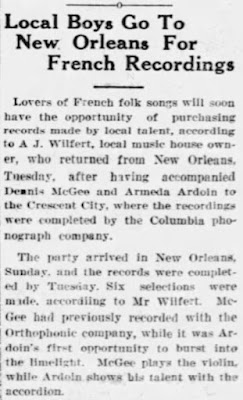The original was done in Atlanta, GA as the flip side to Soileau and Lafleur's famous "Mama Where You At?" recording in October 1928 for Victor. Before the war, others recorded the melody as well. Joe and Cleoma borrowed from the melody for their song "Aimer Et Perdre (To Love and Lose)". After the Depression in 1934, Decca invited Joe and Cleoma Falcon to record in New Orleans in which she used the melody in her song "Ma Valse Preferé". Even Leo would re-use the melody in his later recording of "La Bonne Valse". Their sponsor, Frank Dietlein recalled the session:
[Mayuse] sang a song about his mother, "Mama, Where You At" and it was at this recording session when eh sang his version of "Grand Basile". I soon found out that the Cajun songs were extemporaneous and invariably fitted the mood the singer was in.7
Oh, allons s'en aller dans grand Basile,
Oui, jolie petite fille.
Hé, toi malheureuse qu'est t'as fais,
Oh, moi je t'ai jamais fais rien pour toi faire ça
Toi tite fille, t'auras du regret avant longtemps ça t'as fait.
Toi, jolie petit monde ça t'as fait,
Moi je connais tu vas pleurer, malheureuse, ye yaille,Toi tite fille tu connais j'mérite pas ça toi t'as fait.Oh, jolie fille, malheureuse,Si t'aurais voulu m’écouter chérie,Tu serais dans le grand Basile avec aujourd'hui, chère.Oh, toi 'tite fille chérie,Moi je connais c'est ça, j'm'en vas dans grand Basile,Mais toi 'tite fille, tu peux pas venir me rejoindre,Et même si tu veux, malheureuse, je veux pas te voir.
 |
| Abbeville Meridional Dec 15, 1928 |
Lafleur was an excellent singer and an expressive accordionist. The two men quickly reached simpatico in their playing. It took five hours for the engineers to perfect the vocal levels for the session however, Lafleur's playing was brighter and more enthusiastic than Falcon's more traditional style. The Victor session became infamous after the death of Mayuse nine days later. By 1935, Soileau teamed up with Floyd Shreve, Bill Landry, and Tony Gonzales as the Three Aces. Together, they traveled to New Orleans and re-recorded the tune in a string-band style as "Le Grand Mamou" on both the Bluebird label (#2194) and the Montgomery Ward label (#4880). According to Arheon Vidrine who was interviewed in 1953,
"La Valse de Grand Mamou" was very popular 45 years ago when Edwin Landreneau played it on his fiddle at fais do-dos and sang it with much pathos and feeling. An old Frenchman taught him the song so we tend to believe that it goes further back still. The late Mayuse Lafleur gave it new life in the late twenties.6
 |
| Mayuse Lafleur |
Oh, go, let's go to big Basile,Yes, pretty little girl.Hey, you're so unhappy, how you feel,Oh, I never did anything for you to do that,You little girl, you'll regret this before too long, all you've done.You, pretty little world of mine, what you've done,I know you're going to cry, oh my, ye yaille,You little girl, you know I don't deserve what you've done.Oh pretty girl, oh my,If you wanted to listen to me, dear,You'd be in big Basile with me today, dear.Oh, you little girl, dear,I know that's it, I'm going to big Basile,Well, you little girl, you can not come with me,And even if you want to, oh my, I don't want to see you.
 |
| Cajun music mural Basile, LA |
Since then, many musicians have taken this melody and have put their own spin providing countless recordings since the 50s such as Harry Choates, Ambrose Thibodeaux, Link Davis, Eddie Shuler, Pete Hanley, Ella Mae Morse, Dolores Gray, Jimmy Newman, Everly Brothers, Waylon Jennings, Rod Bernard, and Clifton Chenier.
Over time the song would be interchangeably known as both "Basile" and "Grand Mamou" in the Cajun music circles. Today, however, most of the world knows the tune as "Big Mamou".
- Cajun Breakdown: The Emergence of an American-Made Music By Ryan Andre Brasseaux
- Louisiana Fiddlers By Ron Yule
- http://jopiepopie.blogspot.com/2014/01/basile-waltz-1928-gran-mamou-1935-big.html
- Label scan by University of Louisiana at Lafayette Cajun and Creole Music Collection - Special Collections
- Louisiana Music: A Journey From R&b To Zydeco, Jazz To Country, Blues To Gospel, Cajun Music To Swamp Pop To Carnival Music And Beyond by Rick Koster
- VPG. Apr 23, 1953
- Daily World (Opelousas, Louisiana) 07 May 1974, Tue Page 4
- Lyrics by Stephane F
Le Gran Mamou: A Cajun Music Anthology -- The Historic Victor-Bluebird Sessions, 1928-1941 (Country Music Foundation, 1990)
The Early Recordings of Leo Soileau (Yazoo, 1999)
Cajun Origins (Catfish, 2001)
The Early Recordings of Leo Soileau (Yazoo, 2006)
The Return Of The Stuff That Dreams Are Made Of (Yazoo, 2012)
The Missing Country & Blues Album (Magic Gold, 2014)
Down Home Blues (Goldenlane, 2014)


















